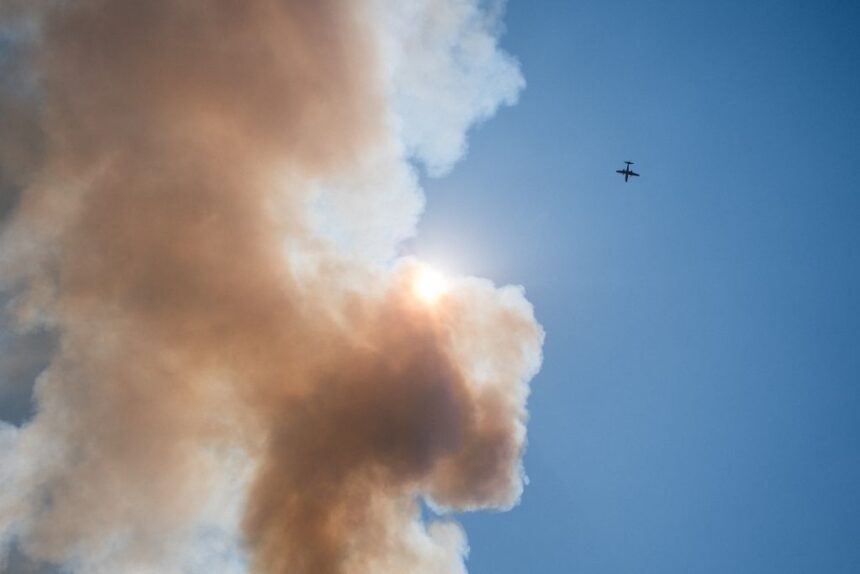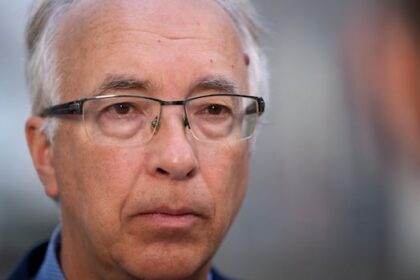Lightning causes nearly half of all wildfires in Canada, but what if you could stop the strikes before they hit? A B.C. company, Skyward Wildfire, is testing cloud-seeding technology it says can prevent “up to 100 per cent of lightning strikes” during periods of high wildfire risk, potentially eliminating lightning-caused fires before they start. Cloud seeding, a geoengineering technology that relies on dispersing particles into the atmosphere to change weather patterns and cloud behaviour, has been around for decades. Alberta uses it to reduce the potential damage from hail storms, often by spraying silver iodide into storm clouds from the wings of airplanes. The particles cause water to condense, freeze and fall as smaller, harmless hailstones instead of the potentially golf-ball sized ones that can occur naturally, and sometimes cause billions of dollars in damage. It has also been used to increase precipitation in the U.S., and there are long-standing claims it can be used to suppress wildfires. In 2021, Russia said it was using cloud seeding to trigger rain over enormous wildfires threatening a power plant in Siberia. The same year, research in the peer-reviewed Environmental Science journal claimed China used cloud seeding to trigger rain and reduce air pollution in Beijing. But Skyward isn’t claiming the ability to turn the heavens into a giant water bomber. Instead, its website says it uses “government-approved methods” to neutralize the potential electric charge in storm clouds during periods of high fire weather risk, reducing lightning strikes — and the fires they can cause — in the first place. In B.C. roughly 60 per cent of wildfires are caused by lightning, including this one in the remote community of Argenta. Photo: Louis Bockner / The Narwhal The company website claims it has partnered with “Canadian Wildfire Services” to test its technology. But wildfire response is organized by provinces, not the federal government, and the company won’t say which provinces it has worked with. In an email, CEO Sam Goldman declined an interview and said he and his staff were not available to comment until the fall. He did not answer questions about the company’s technology, which government agencies it has partnered with or provide information about possible environmental impacts from the use of its technology. The Alberta Wildfire Service did not respond to The Narwhal’s repeated requests for comment. The B.C. Wildfire Service said in a statement that it is aware of Skyward’s efforts, but has no formal partnership agreement with the company and has not provided any funding. It did not say whether it’s aware of any possible testing in B.C. Wildfire technology expert Mathieu Bourbonnais, an associate professor at the University of British Columbia Okanagan, said any time weather modification or geoengineering technology is tested or used, the public deserves to know about it. “We’re talking about fundamentally changing how our weather works when we’re doing these kinds of things. … It’s pretty important that people are aware that it’s happening and why it’s happening,” Bourbonnais said. Skyward’s website says its technology is “proven safe and effective” and that its “methods and materials are safe and comply with all U.S. and Canadian federal requirements.” It uses proprietary modelling technology driven by artificial intelligence (AI) to forecast high-risk lightning storms with the potential to spark wildfires, according to its website. It can then “safely neutralize the electrical potential in clouds, using government-approved methods, thus preventing cloud-to-ground lightning strikes over vulnerable areas,” the website says. While the term cloud seeding does not appear on Skyward’s website, a March press release announcing the company is a finalist for a $200,000 wildfire innovation prize describes the technology as “cloud seeding with safe, non-toxic materials.” Can cloud seeding help prevent wildfires? Throughout the 20th century, two main strategies drove attempts to suppress lightning with cloud seeding. Beginning in the 1950s, a U.S. Forest Service effort called Project Skyfire seeded clouds with silver iodide particles, injected both from aircraft and from cannons positioned on ridge lines and mountain tops. It found cloud seeding with silver iodide nuclei could reduce the frequency of cloud-to-ground lightning strikes by more than 50 per cent, and made strikes that did occur roughly 25 per cent less powerful. Meanwhile, a 1973 technical report published by the U.S. National Oceanic and Atmospheric Administration described tests using “needles” of aluminium-coated glass fibres, a material similar to what’s known as radio frequency chaff, which is commonly deployed by military aircraft to disrupt enemy radar. These tests seemed to confirm elements of the theoretical science behind the idea, but found “a number of questions must be answered before chaff seeding becomes an effective tool for lightning suppression.” In 1976, researchers reported they observed about a third fewer lightning strikes from storms that were seeded with this technique. In the 1950s, the U.S. Forest Service’s Project Skyfire studied the relationship between thunderstorms, lightning strikes and forest fires, aiming to improve fire prediction and prevention methods including cloud seeding. Photo: University of Idaho Library Digital Collections Beyond proving that the science was sound, the biggest hurdle these technologies faced, Bourbonnais said, was accurately predicting when and where to deploy it. “Identifying which [storm] cells and systems are going to be problematic is incredibly difficult even as a starting point,” Bourbonnais explained. “It kind of got abandoned after a handful of trials and maybe a dozen attempts.” If Skyward has solved that problem, it could be a game-changer, especially for Canada. Lightning is responsible for around half of all wildfire starts in Canada and an even higher percentage in the west. In B.C. roughly 60 per cent of wildfires are caused by lightning. What’s more, lightning-caused fires are responsible for the lion’s share of area burned; roughly 85 per cent nation-wide. Given the challenges past technologies faced, Bourbonnais is skeptical of Skyward’s claims it can stop up to 100 per cent of lightning over a given high-risk area. “I have a hard time believing that’s true,” he said, pointing out that some storm cells during high-risk fire periods are capable of delivering tens of thousands of strikes over a period of hours or days. A wildfire tech boom Bourbonnais, who worked as a wildland firefighter for six years, studies how new technologies can be used to help manage wildfire risks. He said there are significant advancements being made in everything from the use of artificial intelligence to improve fire behaviour models to autonomous firefighting drones. One project he helped develop in partnership with the BC Wildfire Service uses remote sensors to automatically detect wildfire risks on the landscape, allowing faster response times and better resource planning. Given the severity of recent wildfire seasons, Bourbonnais does see a possible use for cloud seeding to stop lightning, though only with careful guidelines around its use. Imagine a situation like August 2023. Canada’s wildland firefighting resources were stretched far beyond capacity, even with thousands of firefighters flown in from other countries to help. Multiple communities across B.C. were being hit hard, with hundreds of homes destroyed and another major wind storm on the way. A big lightning storm in that scenario could be devastating, Bourbonnais said. That’s when technology like what Skyward says it’s developing could play a significant role. But cloud seeding is a controversial technology. Critics caution that using it to trigger precipitation could have unintended consequences. A 2022 article in the peer-reviewed journal Bulletin of the Atomic Scientists warned that rather than creating precipitation, cloud seeding may simply shift rainfall and other weather patterns — and risk — from one place to another. There are also some concerns about the cumulative impact of spraying cloud seeding materials into the atmosphere. In 2024, conservation groups in Arizona sued the U.S. Air Force for access to records related to a proposed expansion of military training operations. The plans included the use of radio frequency chaff, which the groups said could endanger wildlife, the environment and public health. Research by both the U.S. and Canadian departments of defence determined radio frequency chaff particles are too large to be inhaled, and are distributed at such small concentrations that the risks to humans and animals are minimal. A review of available data around chaff in military training near Goose Bay, Nfld., produced by Canada’s Department of Defence found the “overwhelming majority of the available data indicate that it is highly unlikely that chaff releases during training exercises will have a significant adverse impact on either ecosystem functioning or human and wildlife health.” But that might not be the only risk. According to a 2023 report by the U.S. Department of Defense, per- and polyfluoroalkyl substances (known as PFAS, or “forever chemicals”) are a component of the propellant used to launch aviation chaff into the atmosphere. If not disposed of carefully, PFAS can contaminate air, water and soil for about 1,000 years. Studies have shown exposure can cause reduced seed germination, stunted growth and reduced photosynthetic activity in plants. The chemicals can then bioaccumulate — build up in the organs of living creatures — in the food chain and are implicated in a host of health issues. Lightning-caused wildfires have a role in many forest ecosystems Even if we could eliminate all lightning-caused wildfires, the better question, Bourbonnais says, is should we? “I think fundamentally, it does sort of precipitate this idea that fire is just bad, and that’s not the case.” Wildfires are a natural and necessary part of many forest ecosystems. They can help prevent forests from becoming overgrown and help create space for beneficial plants like berries and others that animals rely on. Under the right conditions, wildfires also — paradoxically — help protect communities from larger, more destructive wildfires. Western Canada exists in what Bourbonnais calls a “fire deficit,” a result of aggressively suppressing all fires for almost 100 years, which has left forests unnaturally loaded with fuel. Continuing to exclude wildfire from our landscapes just compounds the problem. That means every lightning fire we avoid today just kicks the fire debt further down the road. Eventually Mother Nature will come to collect, often with more devastating consequences. Gitanyow Elder Darlene Vegh is a passionate advocate for using fire to heal the land and the people. She helped lead a cultural burn to restore the landscape in April 2024. Photo: Marty Clemens / The Narwhal We should instead focus on relearning how to live with fire, Bourbonnais said. This would mean investing more in strategies that are time tested but critically underfunded, like forest thinning to reduce wildfire fuel build-up, prescribed and Indigenous cultural burning and more aggressive firesmarting — removing flammable materials, managing vegetation and using fire-resistant building techniques to reduce wildfire risk — around homes and communities. Instituting cloud seeding now is “kind of like slapping a Band-Aid on it, saying, ‘Hey, we can’t have lightning fires right now,’ ” he says. “Fair enough. But what are we doing to reduce that risk in the longer term?” Recent Posts This B.C. company says it can change the weather to stop lightning and wildfires — but won’t say how The startup claims it can prevent wildfires by disrupting lightning before it strikes. Experts say… A visual guide to air pollution in Ontario’s Chemical Valley See how high levels of benzene have been around Aamjiwnaang First Nation — and how… ‘I absolutely had to do the story’: investigating air pollution in Chemical Valley In southern Ontario, Aamjiwnaang First Nation is taking action on exposure to carcinogenic pollutants and…
This B.C. company says it can change the weather to stop lightning and wildfires but wont say how











